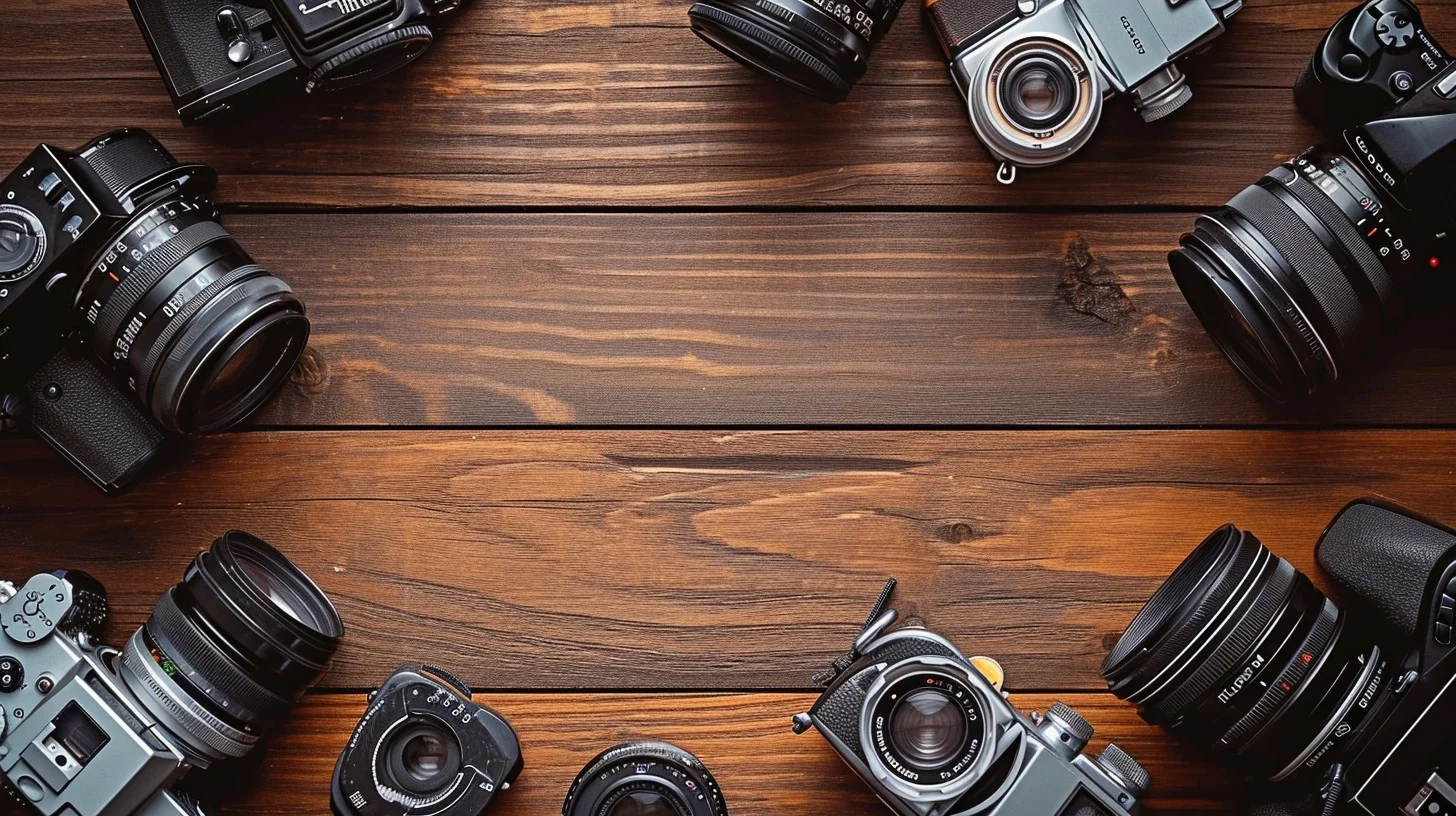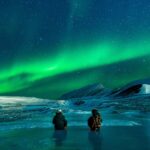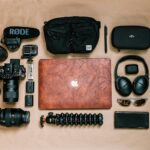
Every landscape photographer feels a rush when light hits mountain peaks. It reveals nature’s most stunning views. I’ve chased these moments for years, learning that the right camera makes all the difference.
Finding the best camera for landscape shots is more than tech specs. It’s about capturing a scene’s essence. Nikon, Sony, and Canon offer great options to freeze beauty and create lasting memories.
My travels have shown me that the perfect camera is a gateway to the world’s beauty. Whether you’re experienced or just starting, the right camera can take your photos to new heights.
Key Takeaways
- Camera selection is key for landscape details
- Different brands offer unique features for landscape photography
- Image quality is more important than megapixels
- Sensor size greatly affects landscape image quality
- Choose a camera that fits your skill level and vision
Why Choosing the Right Camera Matters for Landscapes
Choosing the right camera for landscape photography is more than just picking a pricey model. It’s about how camera quality changes your storytelling. Professional photographers know the right gear can turn a good shot into an amazing image.
Camera quality affects every part of landscape photography. When looking for the best camera settings, photographers need to think about a few key things:
- Color reproduction accuracy
- Dynamic range capabilities
- Resolution and detail preservation
- Low-light performance
The Impact of Camera Quality on Landscape Photography
Top cameras have advanced sensors that catch fine landscape details. These sensors can show textures in mountains, subtle colors in sunrises, and detailed light interactions that cheaper cameras miss.
How Sensor Size Affects Image Detail
Sensor size is key in landscape image quality. Bigger sensors grab more light and offer better dynamic range. This lets photographers capture wide views with clear details. Full-frame sensors usually beat crop sensors in showing fine landscape details.
Knowing these technical points helps you pick a camera that makes your landscape photos stand out.
Key Features to Look for in a Landscape Camera
Choosing the right camera for landscape photography is important. It’s not just about the number of megapixels. It’s about how well it performs in tough outdoor settings.

Looking for the best camera for landscapes? Focus on three key features. They can make a big difference in your photos.
Importance of Lens Compatibility
Lens compatibility is key for landscape photographers. A good camera system should work with many high-quality lenses. This lets you capture different scenes with great detail.
- Wide-angle lenses for expansive landscapes
- Telephoto lenses for distant details
- Macro lenses for detailed natural textures
Weather Sealing and Durability
Outdoor photography needs gear that can handle rough conditions. A camera for landscapes must be weather sealed. This keeps it safe from dust, moisture, and extreme temperatures.
| Weather Sealing Level | Protection Characteristics | Recommended Use |
|---|---|---|
| Basic | Light rain protection | Mild outdoor conditions |
| Advanced | Full environmental protection | Extreme weather scenarios |
| Professional | Sealed body and lens connections | Challenging landscape environments |
Image Stabilization: Why It’s Essential
Image stabilization is a game-changer for landscape photography. A camera with in-body stabilization lets you take clear photos in low light or with slower shutter speeds.
- Reduces camera shake
- Enables longer exposure times
- Improves low-light performance
By focusing on these features, you’ll get a camera system that enhances your landscape photography. It will help you capture stunning scenes with great clarity and detail.
Mirrorless vs. DSLR: Which Is Better for Landscapes?
Choosing the right camera for landscape photography can be tough. Both mirrorless and DSLR cameras have their own benefits for outdoor photography fans. Knowing what each system offers can help you decide on your landscape photography gear.
Landscape photographers have to choose between mirrorless and DSLR cameras. Each system has its own strengths for capturing amazing outdoor scenes.
Advantages of Mirrorless Cameras
- Significantly lighter and more compact design
- Advanced electronic viewfinders with real-time exposure preview
- Silent shooting mode perfect for wildlife and sensitive environments
- Cutting-edge autofocus systems with superior tracking
Mirrorless cameras are great for landscape photography with their new tech. Their light weight is perfect for long hikes and outdoor shoots. The electronic viewfinder lets photographers see exact exposure and color before taking the photo.
Benefits of DSLR Cameras
- Extensive lens compatibility
- Robust build quality for extreme weather conditions
- Longer battery life during extended shooting sessions
- Proven optical viewfinder technology
DSLRs are a solid choice for serious landscape photographers. Their traditional design is reliable and offers many lens options. Professional-grade landscape photography gear often includes DSLR systems because of their durability and consistent performance in tough outdoor environments.
In the end, the best camera depends on your specific needs, shooting style, and personal preferences. Both mirrorless and DSLR systems can create stunning landscape images when used well.
Top Cameras for Landscape Photography in 2023
Choosing the best camera for landscape photos is a big decision. Professional photographers know that the right camera can make a big difference. In 2023, some cameras stand out for their ability to capture stunning landscapes.
When looking for the best camera for landscapes, focus on what makes images better. Look for cameras that capture details well and improve image quality.
Best Mirrorless Cameras for Landscapes
Mirrorless cameras have changed landscape photography. They are small but take amazing photos. Here are three top models:
- Sony α7 IV: Offers exceptional dynamic range and 33-megapixel full-frame sensor
- Nikon Z7 II: Provides remarkable detail and superior weather sealing
- Canon EOS R5: Delivers incredible 45-megapixel resolution with advanced stabilization
Recommended DSLRs for Landscape Photography
Even though mirrorless cameras are popular, some DSLRs are great for landscapes. Here are my top picks:
- Nikon D850: Known for its incredible 45.7-megapixel sensor
- Canon EOS 5D Mark IV: Offers robust build and excellent color reproduction
I’ve made a detailed comparison of these top cameras for landscapes:
| Camera Model | Sensor Resolution | Weight | Price Range |
|---|---|---|---|
| Sony α7 IV | 33MP | 659g | $2,500 |
| Nikon Z7 II | 45.7MP | 705g | $3,000 |
| Canon EOS R5 | 45MP | 738g | $3,900 |
| Nikon D850 | 45.7MP | 1005g | $2,800 |
Each camera has its own strengths for landscape photography. Your choice depends on what you need, your budget, and how you like to shoot. Think about weight, resolution, and extra features when picking.
Lenses That Complement Your Landscape Camera
Choosing the right lens is key for stunning landscape photos. Your camera’s quality depends on the lens you use. Knowing your lens options can greatly enhance your nature photos.
For landscape photography, two lenses are must-haves: wide-angle and telephoto.
Wide-Angle Lenses: Capturing Expansive Scenes
Wide-angle lenses are essential for landscape shots. They let you capture wide views and detailed landscapes.
- Typical focal lengths: 14-35mm
- Perfect for capturing entire landscapes in a single frame
- Emphasizes foreground elements
Telephoto Lenses: Revealing Hidden Perspectives
Telephoto lenses are great for zooming in on scenes. They help you focus on specific parts of the landscape.
- Focal lengths: 70-300mm
- Compress distant mountain ranges
- Highlight intricacies of the landscape
| Lens Type | Best Uses | Recommended Focal Length |
|---|---|---|
| Wide-Angle | Expansive landscapes | 14-35mm |
| Telephoto | Compressed scenes, details | 70-300mm |
I suggest getting both wide-angle and telephoto lenses. Each lens gives you a unique view. This way, you can take a variety of photos that show off nature’s beauty.
Understanding Dynamic Range in Cameras
Dynamic range is key for amazing landscape photos. It’s about how well a camera handles different light levels. Knowing this helps set the best camera settings for stunning shots.

A top camera for landscapes excels in dynamic range. This feature lets the camera show details in both bright and dark parts of a photo.
Breaking Down Dynamic Range
Dynamic range shows how well a camera handles light levels. It’s vital for photographers aiming for top-notch landscape photos.
- Measured in stops of light
- Determines image detail preservation
- Critical for challenging lighting conditions
Why Dynamic Range Matters in Landscape Photography
Landscape shots often face tough lighting. A sunset or a forest with bright sky and dark ground needs great dynamic range. This ensures all details are captured.
| Camera Dynamic Range | Landscape Image Quality | Recommended ISO |
|---|---|---|
| 12-14 stops | Good detail preservation | 64-100 |
| 14-16 stops | Excellent image quality | 64 |
| 16+ stops | Professional-grade results | 50-64 |
Top landscape photographers choose cameras with ISO 64-100. This range offers the best dynamic range and less digital noise. A camera with great dynamic range captures the light and shadow details that make photos stand out.
The Role of Tripods in Landscape Photography
Landscape photography needs precision and stability. As a pro photographer, I’ve found that tripods are key. They make your camera perform better.
Tripods help control image quality. They stop camera shake, giving you sharp images, even in tough light.
Benefits of Using a Tripod
- Enables longer exposure times without blur
- Allows precise composition and framing
- Supports heavy outdoor photography camera equipment
- Facilitates advanced techniques like HDR and panoramic shots
Recommended Tripods for Stability
When picking a tripod, look at weight, durability, and stability. Carbon fiber models are light but strong.
| Tripod Model | Weight | Max Load | Price Range |
|---|---|---|---|
| Manfrotto MT055CXPRO4 | 3.9 lbs | 19.8 lbs | $500-$600 |
| Peak Design Travel Tripod | 3.4 lbs | 20 lbs | $600-$700 |
| Gitzo Mountaineer GT2542 | 3.1 lbs | 22 lbs | $800-$900 |
Getting a good tripod will boost your landscape photos. It adds stability and precision for stunning outdoor shots.
Essential Accessories for Landscape Photographers
Starting with landscape photography means more than just a camera. The right gear can turn ordinary shots into stunning works of art. Let’s explore the must-have accessories for an amazing outdoor photography journey.

Filters: Enhancing Your Landscape Shots
Filters are essential for landscape photography. I suggest two key types:
- Polarizing Filters: These accessories reduce glare and boost color. They’re great for:
- Deepening blue skies
- Reducing water reflections
- Increasing color contrast
- Neutral Density (ND) Filters: These let you take longer exposures. This creates:
- Smooth water effects
- Dramatic cloud movements
- Soft, ethereal landscapes
Protecting Your Gear: Camera Bags Matter
Choosing a good camera bag is vital for landscape photographers. Look for these features:
- Weather-resistant materials
- Padded compartments for protection
- Comfortable carrying systems
- Quick access to equipment
Your gear should match the rugged beauty of the landscapes you capture. The right accessories can elevate your photos from good to extraordinary.
Tips for Capturing Stunning Landscape Photos
Landscape photography is an art that needs skill, patience, and the right approach. As a professional photographer, I’ve learned that mastering the best camera settings can make ordinary scenes into amazing images.
Creating breathtaking landscape photos is more than just pointing your camera at a beautiful scene. The best camera for nature photography combines technical skill with creative vision.
Composition Techniques to Enhance Your Shots
Successful landscape photography relies on powerful composition strategies:
- Rule of Thirds: Divide your frame into a 3×3 grid and place key elements along the intersecting lines
- Leading Lines: Use natural paths like rivers, roads, or fences to guide viewer’s eye
- Foreground Interest: Include interesting elements in the front of your frame to add depth
- Frame Within a Frame: Use natural elements like trees or rocks to create a natural frame
The Best Times of Day for Landscape Photography
Lighting is key for your landscape shots. Golden hour and blue hour offer magical lighting conditions that can elevate your photography:
- Golden Hour: Occurs shortly after sunrise or before sunset, providing warm, soft light
- Blue Hour: The twilight period before sunrise or after sunset with soft, diffused blue tones
- Avoid harsh midday sunlight which creates strong shadows and flat images
By understanding these techniques and timing, you’ll dramatically improve your landscape photography skills. You’ll capture stunning, memorable images.
Editing Software: Enhance Your Landscape Images
Post-processing is key to turning good photos into stunning ones. The right editing software and techniques can take your landscape photos to the next level. This way, you can make them look like they were taken by a pro.
Choosing the right editing tool is important. It can change how you edit your landscape photos. Professional photographers use powerful software to enhance their images.
Popular Editing Tools for Photographers
I’ve looked into many editing platforms to find the best for landscape photography. Here are some top picks:
- Adobe Lightroom: It’s a top choice with lots of editing tools.
- Capture One: Known for its color accuracy and advanced adjustments.
- ON1 Photo RAW: It has a user-friendly interface and great features for landscapes.
Basic Editing Techniques to Consider
There are key editing techniques for landscape photos:
- Exposure Adjustment: It helps balance light and shadow.
- Color Correction: It enhances natural colors.
- Sharpening: It makes small details stand out.
| Software | Best For | Price Range |
|---|---|---|
| Adobe Lightroom | Professional Workflow | $9.99/month |
| Capture One | Color Precision | $24/month |
| ON1 Photo RAW | Creative Editing | $79.99/year |
Learning these editing techniques and using the right tools can unlock your photos’ full beauty. You’ll turn raw captures into stunning visual stories.
Conclusion: Selecting Your Ideal Camera for Landscapes
Finding the best camera for landscape pictures is a personal journey. It’s about matching your photography goals with the right equipment. Every photographer has different needs, so there’s no single camera that fits everyone.
When looking at cameras, focus on what improves your landscape photos. Things like sensor size, dynamic range, and lens options are key. Your budget and how you like to shoot will help you choose the best camera for you.
Start with a camera system that’s flexible and can grow with you. Whether it’s mirrorless or DSLR, choose one that offers great image quality and durability. Remember, it’s not just about the camera’s specs. Your creativity turns ordinary scenes into amazing photos.
Your journey in landscape photography is ongoing. The right camera is just a tool to help tell your story. Spend time learning about your gear, practicing your craft, and finding your unique style. With the right camera and dedication, you’ll make photos that touch people’s hearts.
FAQ
What is the most important feature to consider when choosing a camera for landscape photography?
Sensor size and resolution are key. A bigger sensor with more megapixels means better detail and quality prints. It also helps with dynamic range, which is vital for landscapes.
Should I choose a mirrorless or DSLR camera for landscape photography?
Mirrorless cameras are lighter and have cool features. DSLRs are sturdy and have more lens options. Your choice depends on what you like, your budget, and your needs.
What lens types are best for landscape photography?
Wide-angle lenses (14-35mm) are great for big views. Telephoto lenses (70-200mm) are good for distant shots. A zoom lens offers flexibility.
How important is dynamic range in landscape cameras?
Dynamic range is very important. It lets your camera handle bright and dark areas well. This is key for shots in tricky light, like sunrise or sunset.
Do I really need a tripod for landscape photography?
Yes, a tripod is a must. It lets you use slower shutter speeds and get sharp photos. It’s also great for long exposures and keeping your shots steady.
What additional accessories should I consider for landscape photography?
Think about polarizing filters for better colors and less glare. Neutral density filters are good for long shots. Also, get a strong but light camera bag, extra batteries, and lots of memory cards.
Which camera brands are best for landscape photography?
Sony, Canon, Nikon, and Fujifilm are top picks. They offer high-quality cameras with great dynamic range and durability for outdoor use.
How many megapixels do I need for landscape photography?
For top-notch landscapes, look for 24-50 megapixels. This gives you enough detail for big prints and allows for cropping without losing quality.
What camera settings work best for landscape photography?
Use a small aperture (f/8-f/16) for deep focus. Keep the ISO low (100-400) to avoid noise. Manual focus is best for sharp images. Shooting in RAW gives you more editing options.
How do I protect my camera during outdoor landscape photography?
Choose a weather-sealed camera. Use protective filters and carry a weather-resistant bag. Rain covers or protective cases are good for tough weather.
Affiliate Disclosure
This website/blog/content contains affiliate links. This means if you click on one of these links and make a purchase, I may receive a small commission at no additional cost to you.
I only recommend products and services that I genuinely believe in and have personally used or thoroughly researched. While I do receive compensation for these recommendations, my opinions remain honest and unbiased.
The commissions earned help support this website and allow me to continue providing valuable content. I appreciate your support when you use these links, but you are never obligated to make purchases through them.
Please note that prices of products or services may vary, and I have no control over these prices or the availability of items. All recommendations are made based on my assessment at the time of posting.
Thank you for your understanding and support.



